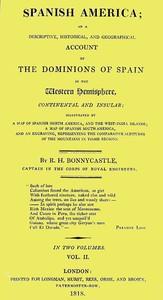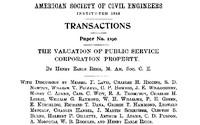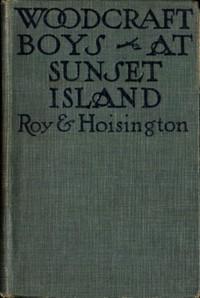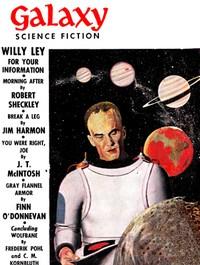Read this ebook for free! No credit card needed, absolutely nothing to pay.
Words: 123626 in 61 pages
This is an ebook sharing website. You can read the uploaded ebooks for free here. No credit cards needed, nothing to pay. If you want to own a digital copy of the ebook, or want to read offline with your favorite ebook-reader, then you can choose to buy and download the ebook.


: Spanish America Vol. 2 (of 2) by Bonnycastle Richard Henry Sir - Latin America History; Latin America Description and travel
ans, or alligators, are very numerous, and very formidable throughout its whole length, which may be estimated at about 1250 miles.
To the north of the Orinoco, there are few natives in a state of absolute barbarism; it is only to the south of this river that the efforts of missionaries have been ineffectual.
The Chaymas, the Caribs of the Savannahs, and the Cumanagotoes, are the most numerous. A few, and only a few, of the savages of the islands of the Orinoco, who build their huts on trees, have been formed into missions on the left bank of the Orinoco. These four last possess languages which are the most universal in this part of the world, the Cumanogoto language prevailing in the western part of the captain-generalship, and the Caribbean and Chayman in the southern and eastern districts.
The missions are not always formed of the same tribe, but often consist of families of different nations, speaking different languages; they all cultivate the land, their huts are all erected in the same style, and they have all a common field for the uses of the community, and are governed by fixed laws; the magistrates are chosen from among themselves, and each village is superintended in its religious and civil affairs by a monk.
In stature, the natives of this tribe are short, being not more than five feet two inches, their body thick, with broad shoulders and flat chest, their colour a dull brown, and they are of a melancholic temperament.
They have a great aversion to European clothing, and remain naked whilst in their houses, but when obliged to go out, they put on a vest with sleeves, which reaches almost to the knees; the women wear this habit without the sleeves, and both sexes use a narrow bandage tied round the loins: they also carefully eradicate the hair from the chin, and are a neat people, keeping their persons, houses and utensils very clean.
Five or six hundred of this race quitted the islands a short time ago, and formed two villages on the north and south banks of the great river, twenty-five leagues distant from the sea, where they live independent of the missionaries. They are of a middle size, and very strong, and are able to run on the mud of the marshes, where no other Indians can walk. These people are the pilots of the Orinoco, possessing a perfect knowledge of its navigation, and are concerned in the clandestine commerce carried on from Trinidad.
The produce of the interior is conveyed by the rivers which feed it, to the town of Maracaybo, and thence shipped for Europe or the adjoining colonies; and the various sorts of fish, common to the American rivers, are to be found in this lake.
The shores in the immediate vicinity of its waters, are unhealthy, owing to the vapours arising in the night after the great heat of the day.
When the Spaniards first landed in this country, they observed several villages built in the lake, which is the mode adopted by the Indians at present, considering this plan as the healthiest.
The appearance of one of these little towns amid the waters, caused the Spanish adventurers to name it Little Venice, or Venezuela, which title was afterwards transferred to the whole province in the neighbourhood. Four of these villages still remain, and are under the government of a monk, who has a church, and the spiritual charge of these people.
The principal employment of the Indians of these towns is fishing and catching the aquatic birds which frequent the lake.
Free books android app tbrJar TBR JAR Read Free books online gutenberg
More posts by @FreeBooks

: The Valuation of Public Service Corporation Property Transactions of the American Society of Civil Engineers vol. LXXII June 1911 ASCE 1190 by Riggs Henry Earle - Civil engineering Periodicals; Railroads Valuation


: The Pilot and the Bushman by Jacobs Sylvia Stone David Illustrator - Science fiction; Advertising Fiction; Human-alien encounters Fiction; Business Fiction Science Fiction




